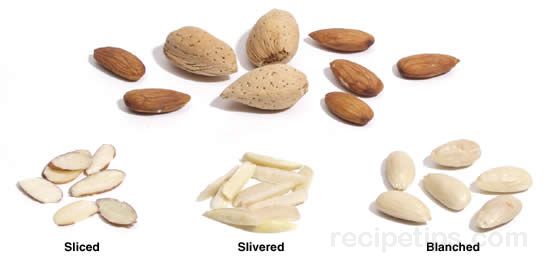An oval, tan-colored nut harvested from a tree that is related to the rose family. Almonds are available as either a bitter or as a sweet flavored type of nut. The bitter nut must be cooked in order to remove a naturally occurring toxin, so they are not consumed raw, but instead are processed for almond oil or almond extract. It is the sweet almond that is the nut commonly available to be served as snacks or added to salads, entrees, side dishes, baked goods, and desserts. There are a variety of almonds available in both different types and forms. As an example, Marcona almonds are a Spanish variety that are more plump than other varieties and richer in flavor. Almonds can be purchased in the shell, shelled whole, sliced, slivered, chopped, or ground. They can be blanched (skins removed), roasted or used as a raw nut.
When preparing almonds, roasting the almond at 350 degrees F for approximately 10 minutes enhances the nutty flavor for snacking or as an ingredient to other foods. Blanching also improves the flavor, which can be accomplished by placing the nut in cold water, boiling for 2 minutes, draining the water, and then removing the outer skins. For recipes requiring almonds, a quarter pound of almonds equals 1 cup of finely ground almonds.
To store almonds, store them in a refrigerator or for longer periods of time in a freezer. Always keep the nuts away from heat, sunlight and other foods with strong aromas, since they easily absorb other odors, thus changing their flavor.
















